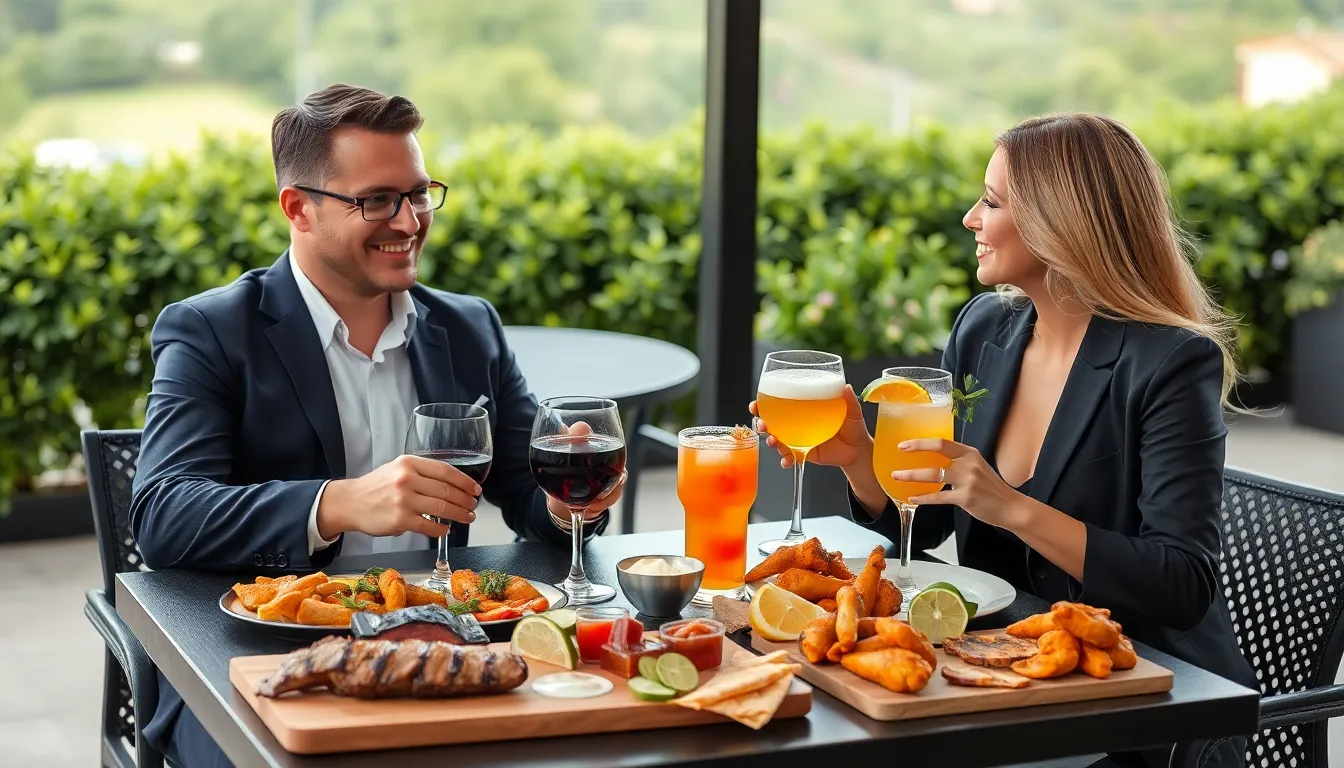Finding the perfect alcohol pairing can elevate any dining experience. Whether it’s a robust red wine complementing a juicy steak or a crisp lager enhancing the flavors of spicy tacos, the right drink can transform a meal into a memorable occasion. Understanding the nuances of flavor profiles is essential for anyone looking to impress at their next gathering.
As culinary trends evolve, so does the art of pairing drinks with food. With countless options available, from craft beers to artisanal cocktails, navigating this world can feel overwhelming. However, mastering the basics of alcohol pairings opens up a realm of possibilities that can delight the palate and enhance the overall dining experience. Dive into the exciting journey of discovering how to harmonize food and drink for unforgettable moments.
Table of Contents
ToggleUnderstanding Alcohol Pairings
Alcohol pairings play a vital role in elevating dining experiences. By selecting the right drink, an individual can significantly enhance the flavor and overall enjoyment of a meal.
The Importance of Pairing
Pairing alcohol with food can transform a good meal into a great one. Complementing flavors enhances both the drink and the dish. For example, a fruity Sauvignon Blanc pairs well with fresh seafood, highlighting the dish’s natural flavors. Conversely, a full-bodied Merlot may overpower lighter fare but complements richer meats. Understanding the relationship between food and drink leads to memorable dining occasions.
Flavor Profiles in Alcohol
Flavor profiles reveal the tastes and aromas present in various alcoholic beverages. Key profiles include:
- Sweetness – Found in certain wines and cocktails, sweetness can balance savory and spicy dishes.
- Bitterness – Common in IPAs, bitterness pairs well with fatty foods, cutting through richness.
- Acidity – Bright acidity in drinks like sparkling wine sharpens and refreshes palate contrasts.
- Tannin – Present in red wines, tannins add structure and complexity, pairing well with proteins like beef.
- Body – Full-bodied drinks provide a rich mouthfeel, best with hearty dishes, while lighter drinks serve well with delicate flavors.
Understanding these profiles assists in making informed pairing choices. Each drink brings its unique attributes to the table, enhancing the overall culinary experience.
Popular Alcohol Pairings

Pairing alcohol with food or snacks can significantly enhance flavors and elevate the overall dining experience. Here are some popular combinations that highlight complementary tastes.
Wine with Food
Wine serves as an excellent companion to various dishes, enhancing the meal by matching or contrasting flavors.
- Red Wine: Red wines, like Cabernet Sauvignon and Merlot, complement hearty meals such as grilled steak or lamb.
- White Wine: Crisp white wines, such as Sauvignon Blanc and Chardonnay, enhance lighter dishes like grilled fish or chicken salads.
- Rosé: Rosé wine works well with charcuterie boards and tapas, providing versatility across flavors.
- Sparkling Wine: Sparkling options, including Champagne and Prosecco, pair nicely with salty foods like fried calamari or potato chips.
Beer with Snacks
Beer’s wide range of flavors makes it a popular choice for snacks and casual meals.
- Pale Ale: Pale ales offer a hoppy flavor that complements spicy buffalo wings or nachos.
- Stout: Rich stouts pair well with chocolate desserts, enhancing the sweetness with robust bitterness.
- Wheat Beer: Wheat beers, such as Hefeweizen, work well with light salads or seafood, marrying their refreshing profile with delicate flavors.
- Lager: Crisp lagers enhance barbecued meats and fatty dishes, cleansing the palate effectively.
Spirits with Cocktails
Spirits provide a base for cocktails, allowing for creativity and flavor exploration.
- Vodka: Vodka serves as a versatile ingredient in cocktails like the Moscow Mule or Bloody Mary, balancing flavors with its neutrality.
- Gin: Herbal gin adds complexity to cocktails such as the Gimlet or Negroni, celebrating botanical notes that marry well with citrus and spices.
- Rum: Rum, particularly in dark or spiced varieties, enhances tropical cocktails like the Mai Tai or Piña Colada, fitting perfectly with fruity ingredients.
- Whiskey: Whiskey’s richness pairs well with sweet mixers in drinks like the Old Fashioned or Whiskey Sour, combining notes of oak and caramel for a satisfying experience.
Tips for Perfect Alcohol Pairings
Finding the right balance between food and drink enhances dining experiences. Following certain guidelines helps achieve perfect alcohol pairings.
Balancing Flavors
Balancing flavors involves matching the intensity of food with the drink’s characteristics. Alcohol can complement or contrast food flavors effectively.
- Strength: Match robust dishes with bold wines such as Syrah or Zinfandel.
- Sweetness: Pair sweet desserts with lighter wines like Moscato or Riesling.
- Acidity: Use high-acid wines like Vermentino for fatty dishes, which cleanse the palate.
- Bitterness: Counterbalance bitter flavors in food with smooth, fruity drinks like Spumante.
Understanding these elements leads to more satisfying pairings that enhance overall flavor profiles.
Considering Aromatics
Aromatics play a crucial role in pairing choices. They create an inviting experience and can enhance overall enjoyment.
- Herbaceous: Wines like Sauvignon Blanc match well with dishes featuring herbs like basil or cilantro.
- Fruity: Spirits infused with fruits complement similar flavored desserts or fruity appetizers.
- Spicy: Drinks with spice notes, like a ginger-infused cocktail, pair effectively with Thai or Indian cuisine.
- Woody: Aged spirits, such as bourbon, work well with smoked meats and grilled dishes.
Aligning aromatic profiles with food enhances enjoyment, creating harmonious pairings that resonate on the palate.
Common Pairing Mistakes
Pairing alcohol with food often leads to common mistakes that detract from the dining experience. Recognizing these errors helps in making better choices.
- Ignoring Flavor Profiles: Many overlook the fundamental flavor components of both the food and the drink. For instance, pairing a sweet wine with a spicy dish may conflict instead of complementing the flavors.
- Pairing Similar Intensity: Many fail to match the intensity of the drink with the food. Pairing light dishes, like salads, with heavy beers or bold wines overwhelms the palate.
- Neglecting Aromatics: Many disregard the impact of aromatic flavors in both food and drinks. Pairing herbaceous cocktails with dishes that feature strong herbs creates a harmonious taste experience that enhances both elements.
- Choosing Incompatible Colors: Many believe that matching colors alone applies to food and drink pairings. For example, pairing a dark beer with a light seafood dish might not provide the intended balance.
- Overthinking Simple Pairings: Many complicate the process by striving for unique combinations, while classic pairings often yield excellent results. A well-structured wine with a standard cheese plate can provide the perfect balance without unnecessary complexity.
- Rushing to Decide: Many rush through the selection process without considering personal preferences. Taking time to explore various pairings ensures a more enjoyable experience tailored to individual tastes.
By avoiding these common pairing mistakes, individuals can achieve more successful alcohol pairings that enhance the overall dining experience.
Finding the right alcohol pairing can truly transform a meal into an unforgettable experience. By understanding flavor profiles and the characteristics of different drinks, individuals can create harmonious combinations that elevate both food and drink. Whether it’s a bold wine with a rich dish or a refreshing beer with spicy cuisine, the right pairing enhances enjoyment and satisfaction.
Avoiding common pitfalls in pairing choices ensures that the dining experience remains delightful. With a bit of knowledge and creativity, anyone can master the art of alcohol pairings and explore a world of flavors that complement each other beautifully. Embracing this culinary adventure opens up endless possibilities for memorable meals and enjoyable gatherings.






